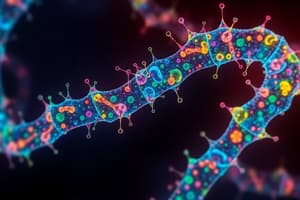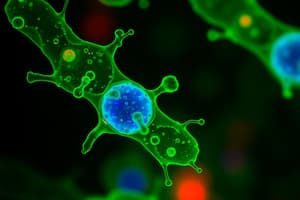Podcast
Questions and Answers
Which of the following is true about immunofluorescence?
Which of the following is true about immunofluorescence?
- It uses antibodies to target fluorescent dyes to specific biomolecule targets. (correct)
- It is primarily used to analyze the distribution of DNA.
- It is used primarily on non-biological samples.
- It is a technique used for electron microscopy.
What is the specific region on an antigen recognized by an antibody called?
What is the specific region on an antigen recognized by an antibody called?
- Antibody-antigen complex
- Fluorophore
- Biomolecule target
- Epitope (correct)
Which technique is immunofluorescence an example of?
Which technique is immunofluorescence an example of?
- Immunohistochemistry (correct)
- Immunoblotting
- Immunocytochemistry
- Immunostaining
Which type of immunofluorescence technique uses a single, primary antibody, chemically linked to a fluorophore?
Which type of immunofluorescence technique uses a single, primary antibody, chemically linked to a fluorophore?
What is the advantage of using secondary (indirect) immunofluorescence over primary (direct) immunofluorescence?
What is the advantage of using secondary (indirect) immunofluorescence over primary (direct) immunofluorescence?
Which microscope design is the simplest and widely used for analysis of immunofluorescence samples?
Which microscope design is the simplest and widely used for analysis of immunofluorescence samples?
What is a disadvantage of direct immunofluorescence compared to indirect immunofluorescence?
What is a disadvantage of direct immunofluorescence compared to indirect immunofluorescence?
Which of the following is a limitation of immunofluorescence?
Which of the following is a limitation of immunofluorescence?
What is one way to control photobleaching in immunofluorescence?
What is one way to control photobleaching in immunofluorescence?
Why is immunofluorescence limited to fixed cells?
Why is immunofluorescence limited to fixed cells?
What is the purpose of using recombinant proteins containing fluorescent protein domains in immunofluorescence?
What is the purpose of using recombinant proteins containing fluorescent protein domains in immunofluorescence?
Which type of microscope has a higher resolution compared to light microscopes?
Which type of microscope has a higher resolution compared to light microscopes?
Which development in electron optics allowed for the manipulation of the direction of an electron beam?
Which development in electron optics allowed for the manipulation of the direction of an electron beam?
Which type of electron microscopy is used for chemical analysis?
Which type of electron microscopy is used for chemical analysis?
Which team of researchers successfully generated magnified images of mesh grids placed over an anode aperture in 1931?
Which team of researchers successfully generated magnified images of mesh grids placed over an anode aperture in 1931?
Who is considered the inventor of the electron microscope according to patent law?
Who is considered the inventor of the electron microscope according to patent law?
When did Ruska and Knoll build the first electron microscope that exceeded the resolution attainable with an optical microscope?
When did Ruska and Knoll build the first electron microscope that exceeded the resolution attainable with an optical microscope?
Which company produced the first commercial electron microscope in 1938?
Which company produced the first commercial electron microscope in 1938?
Which of the following microscopes has the ability to determine the positions of atoms within materials?
Which of the following microscopes has the ability to determine the positions of atoms within materials?
Which of the following is an advantage of electron diffraction over X-ray crystallography?
Which of the following is an advantage of electron diffraction over X-ray crystallography?
Which microscope design produces images with a single brightness value per pixel?
Which microscope design produces images with a single brightness value per pixel?
Which microscope design has a greater depth of field and can produce images that represent the three-dimensional surface shape of a sample?
Which microscope design has a greater depth of field and can produce images that represent the three-dimensional surface shape of a sample?
Which of the following components is NOT typically found in a fluorescence microscope?
Which of the following components is NOT typically found in a fluorescence microscope?
What is the purpose of the spectral emission filter in a fluorescence microscope?
What is the purpose of the spectral emission filter in a fluorescence microscope?
Which type of microscope design is commonly used for immunofluorescence samples?
Which type of microscope design is commonly used for immunofluorescence samples?
Which type of microscopy technique allows scientists to directly make a protein of interest fluorescent in biological samples?
Which type of microscopy technique allows scientists to directly make a protein of interest fluorescent in biological samples?
What is one limitation of fluorescence microscopy?
What is one limitation of fluorescence microscopy?
Which microscopy technique allows observation of the specific structures that have been labeled for fluorescence?
Which microscopy technique allows observation of the specific structures that have been labeled for fluorescence?
Which microscopy technique aims to reach past the diffraction limit by using specialized optical configurations?
Which microscopy technique aims to reach past the diffraction limit by using specialized optical configurations?
Which type of microscope design is commonly used for widefield epifluorescence microscopy?
Which type of microscope design is commonly used for widefield epifluorescence microscopy?
What is the main purpose of fluorescent staining in fluorescence microscopy?
What is the main purpose of fluorescent staining in fluorescence microscopy?
Which type of light source is commonly used for confocal microscopy and total internal reflection fluorescence microscopy?
Which type of light source is commonly used for confocal microscopy and total internal reflection fluorescence microscopy?
What is the technique called that uses the specific binding of an antibody to label specific proteins or molecules within a cell?
What is the technique called that uses the specific binding of an antibody to label specific proteins or molecules within a cell?
Which of the following is true about fusion proteins?
Which of the following is true about fusion proteins?
What is an example of an oncogenic fusion protein?
What is an example of an oncogenic fusion protein?
What can be the result of interactions between two proteins in a fusion protein?
What can be the result of interactions between two proteins in a fusion protein?
Which of the following is NOT a property that can be increased through fusion protein design?
Which of the following is NOT a property that can be increased through fusion protein design?
What is the purpose of linker peptides in fusion proteins?
What is the purpose of linker peptides in fusion proteins?
Which technique is commonly used for the identification and purification of proteins in fusion proteins?
Which technique is commonly used for the identification and purification of proteins in fusion proteins?
Which of the following fusion protein design techniques involves connecting the proteins of interest end-to-end?
Which of the following fusion protein design techniques involves connecting the proteins of interest end-to-end?
Which of the following is true about chimeric protein drugs?
Which of the following is true about chimeric protein drugs?
What is the advantage of using photoconvertible fluorescent proteins (PCFPs) as tags in protein tracking?
What is the advantage of using photoconvertible fluorescent proteins (PCFPs) as tags in protein tracking?
What is the purpose of creating recombinant fusion proteins?
What is the purpose of creating recombinant fusion proteins?
How are humanized antibodies different from chimeric antibodies?
How are humanized antibodies different from chimeric antibodies?
Flashcards are hidden until you start studying
Study Notes
Immunofluorescence
- Immunofluorescence is a technique that uses antibodies or immunoglobulins to detect specific proteins in cells.
- The specific region on an antigen recognized by an antibody is called an epitope.
Types of Immunofluorescence
- Direct immunofluorescence uses a single, primary antibody chemically linked to a fluorophore.
- Indirect immunofluorescence uses a primary antibody and a secondary antibody conjugated to a fluorophore.
- The advantage of using secondary (indirect) immunofluorescence over primary (direct) immunofluorescence is that it increases sensitivity and flexibility.
Microscope Designs
- The simplest and widely used microscope design for analysis of immunofluorescence samples is the epifluorescence microscope.
- Confocal microscopy has a higher resolution compared to light microscopes.
- Electron microscopy has a higher resolution compared to light microscopes.
- Scanning electron microscopy (SEM) has a greater depth of field and can produce images that represent the three-dimensional surface shape of a sample.
Limitations and Controls
- A disadvantage of direct immunofluorescence compared to indirect immunofluorescence is lower sensitivity.
- A limitation of immunofluorescence is photobleaching, which can be controlled by reducing light intensity, using antioxidants, or taking images quickly.
- Immunofluorescence is limited to fixed cells because the procedure requires cell fixation to preserve antigenicity.
Recombinant Proteins and Fusion Proteins
- Recombinant proteins containing fluorescent protein domains are used in immunofluorescence to create fusion proteins.
- The purpose of using recombinant proteins is to create fluorescently labeled proteins for tracking and detection.
- An example of an oncogenic fusion protein is BCR-ABL1, which is a hallmark of chronic myeloid leukemia.
- Fusion proteins can lead to changes in protein function, localization, or stability.
- Linker peptides are used in fusion protein design to connect proteins of interest.
Microscopy Techniques
- Confocal microscopy uses a laser and pinhole to produce images with a single brightness value per pixel.
- Total internal reflection fluorescence microscopy (TIRFM) uses an evanescent wave to produce images near the surface of a sample.
- Fluorescence microscopy is limited by the diffraction limit, which can be overcome by using specialized optical configurations (super-resolution microscopy).
- Chimeric proteins are generated by combining parts of two proteins from different species.
Antibody Drugs and Proteins
- Chimeric protein drugs are used to reduce immunogenicity and increase efficacy.
- Humanized antibodies are different from chimeric antibodies in that they have more human-derived components.
- Photoconvertible fluorescent proteins (PCFPs) are used as tags in protein tracking due to their ability to change fluorescence emission wavelengths.
- The purpose of creating recombinant fusion proteins is to study protein function, localization, and interactions.
Studying That Suits You
Use AI to generate personalized quizzes and flashcards to suit your learning preferences.




